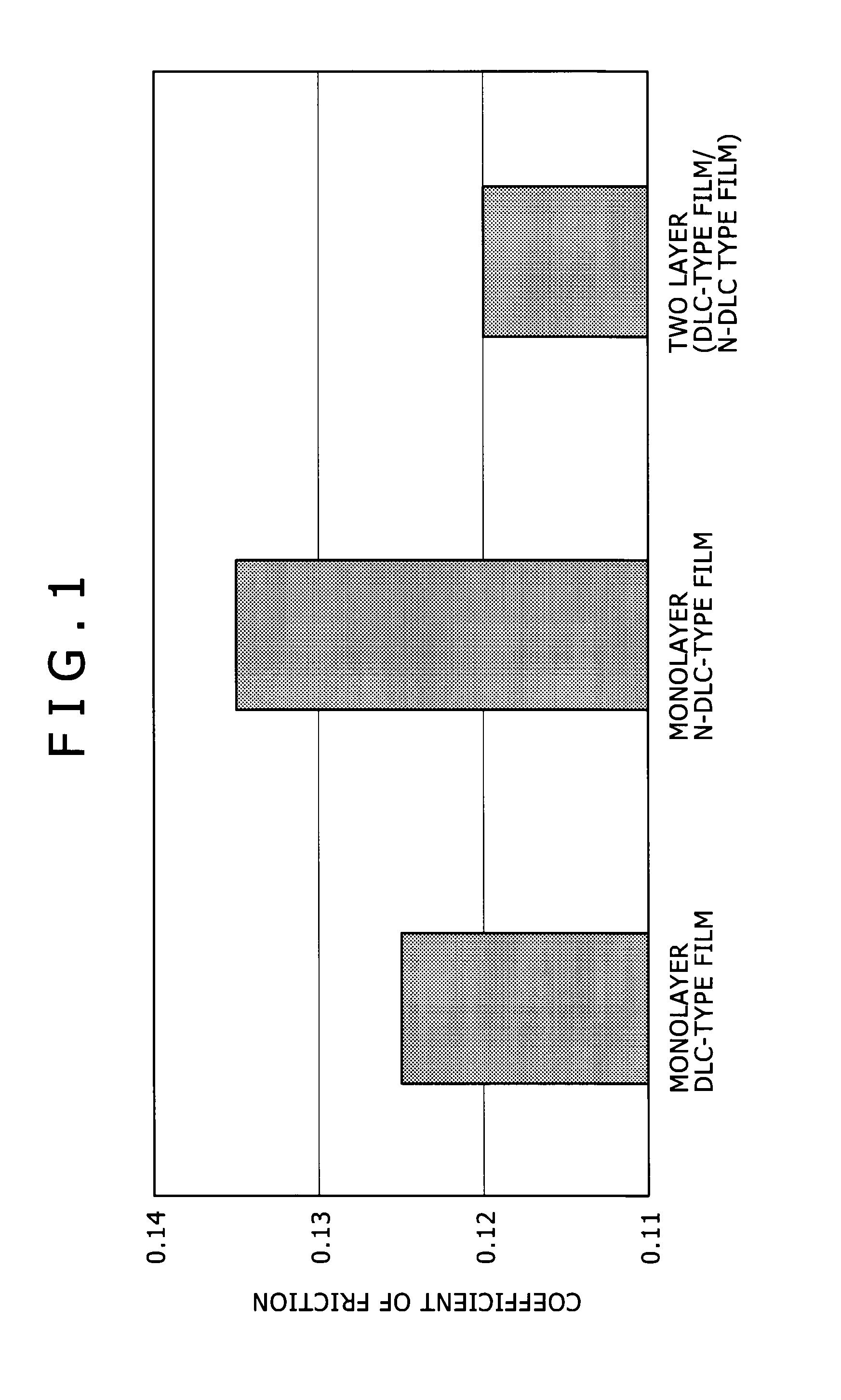Nitrogen-containing amorphous carbon-type film, amorphous carbon-type lamination film, and sliding member
a technology lamination film, which is applied in the direction of mechanical equipment, machines/engines, transportation and packaging, etc., can solve the problems of unfavorable enhancement of the hardness of amorphous carbon type film as expected, and achieve excellent seizure resistance, small coefficient of friction, and excellent wear resistance
- Summary
- Abstract
- Description
- Claims
- Application Information
AI Technical Summary
Benefits of technology
Problems solved by technology
Method used
Image
Examples
example 1
[0053]As a PVD device, using an unbalanced type magnetron sputtering device with a carbon target (target diameter 6 inch) as an evaporation source (UBM202, manufactured by Kobe Steel, Ltd.), amorphous carbon-type films shown in Table 1 were deposited. When an intermediate layer described later is formed, a Cr target is further used. For deposition of the amorphous carbon-type film, a mixed gas of Ar (argon), CH4 (methane), and N2 (nitrogen) was used.
[0054]As a base material, for analysis of the hydrogen content and the nitrogen content, a Si substrate was used; for evaluation of the hardness and the Young's modulus, a mirror-surface-polished hard metal; and for sliding test evaluation, a mirror-surface-polished SKH51 disk.
[0055]The base material was introduced in the device. Evacuation was carried out to 1×10−3 Pa or less, and heating was carried out until the base material temperature was 400° C. Then, sputtering cleaning using Ar ions was carried out. Then, for a sample including ...
example 2
[0069]As a base material, for analysis of the hydrogen content and the nitrogen content, a Si substrate was used; and for sliding test evaluation, a mirror-surface-polished SKH51 disk was used. On the base materials, the following deposition was performed in the same manner as in Example 1. First, in the same manner as in Example 1, a Cr film (film thickness: 0.2 μm) and a Cr carbide film (a gradient structure layer of Cr and C, film thickness: 0.5 μm) were sequentially formed as an intermediate layer on the substrate. As a result, the adhesion between the base material and the film (each amorphous carbon-type film, monolayer N-DLC-type film or monolayer DLC-type film) to be deposited next.
[0070]On the surface of the intermediate layer, first, an amorphous carbon-type film (DLC-type film, film thickness: 0.9 μm) was formed. Deposition of the DLC-type film was carried out under the conditions of a CH4 flow rate: 1 sccm, and an Ar flow rate: 99 sccm. Then, on the DLC-type film, a N-DL...
PUM
| Property | Measurement | Unit |
|---|---|---|
| Fraction | aaaaa | aaaaa |
| Fraction | aaaaa | aaaaa |
| Fraction | aaaaa | aaaaa |
Abstract
Description
Claims
Application Information
 Login to View More
Login to View More - R&D
- Intellectual Property
- Life Sciences
- Materials
- Tech Scout
- Unparalleled Data Quality
- Higher Quality Content
- 60% Fewer Hallucinations
Browse by: Latest US Patents, China's latest patents, Technical Efficacy Thesaurus, Application Domain, Technology Topic, Popular Technical Reports.
© 2025 PatSnap. All rights reserved.Legal|Privacy policy|Modern Slavery Act Transparency Statement|Sitemap|About US| Contact US: help@patsnap.com


